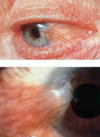Eyes Flashcards
(49 cards)
Diplopia
double vision
Scotomas
fixed spots of vision loss
Myopia
nearsightedness
Hyperopia
farsightedness
Presbyopia
aging related loss of ability to focus on objects close to eye
Periocular
in eye
Perioirbital
around eye
Pruritus
itching
Photophobia
extreme sensitivity to light
Glaucoma
group of diseases that damage the eye’s optic nerve and can result in vision loss and blindness (often due to pressure build up)
Macular degeneration
major cause of gradual, painless, bilateral central visual loss in the elderly; occurs in a nonexudative (dry) form and an exudative (wet) form
Cataracts
opacities of the crystalline lens and are usually bilateral; leading cause of blindness worldwide

Strabismus
one eye looks directly at the object you are viewing, while the other eye is misaligned
Snellen chart
pt should be 20 ft from chart, result is based on the smallest line the pt can read at least 50% correctly

Oculus Dexter
right eye visual acuity
Oculus Sinstra
left eye visual acuity
Oculus Uterque
both eye visual acuity
Blind eye
complete vision loss in one eye (optic nerve likely affected)
Bitemporal hemianopsia
partial vision loss of the temporal side of both eyes (optic chiasm likely affected)
Left or right homonymous hemianopsia
partial vision loss of both right or both left sides of each eye (optic tract likely affected)
Proptosis
eye bulging
Esotropia
strabismus inward
Exotropia
strabismus outward
Palpebral fissue
distance between eyelids























